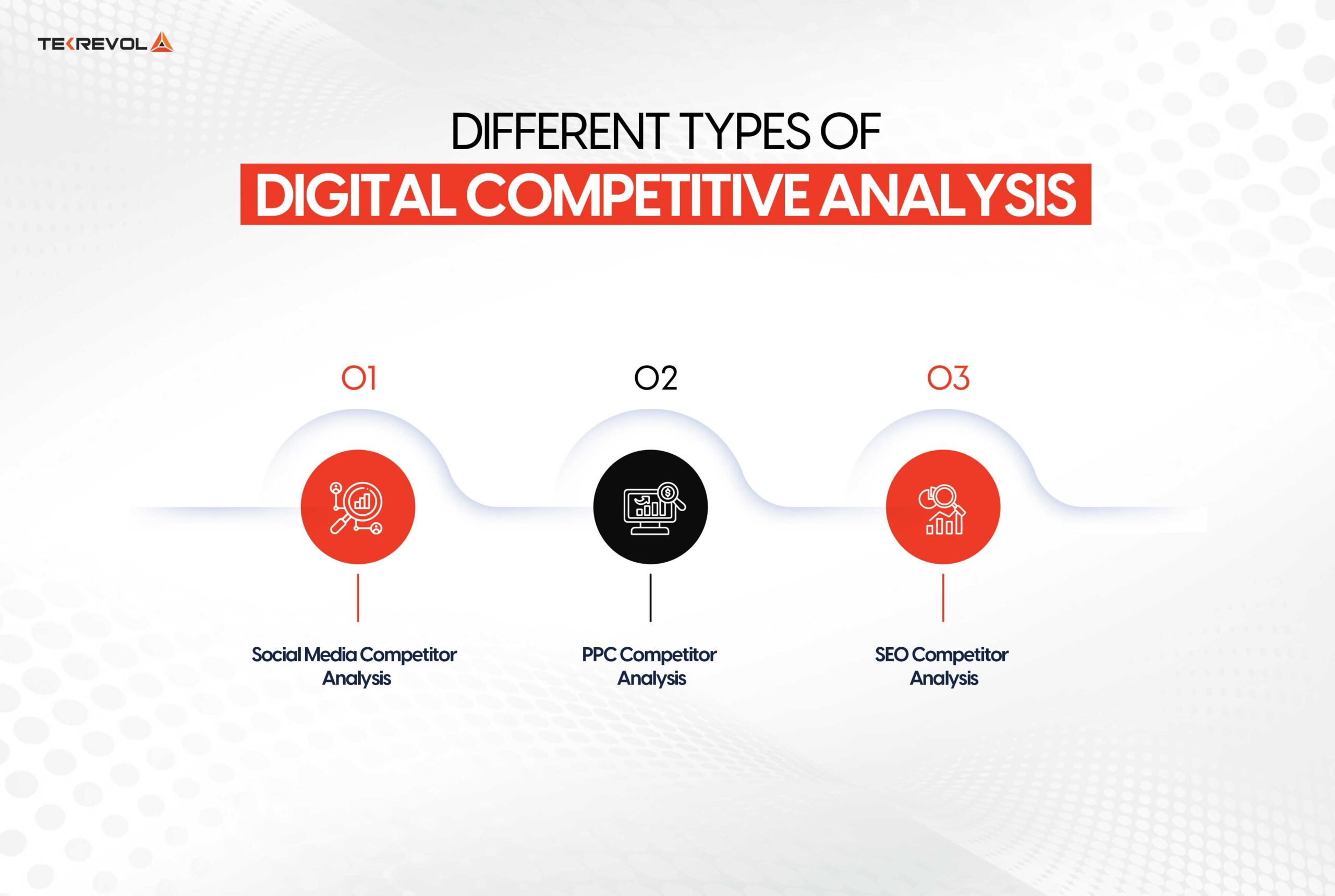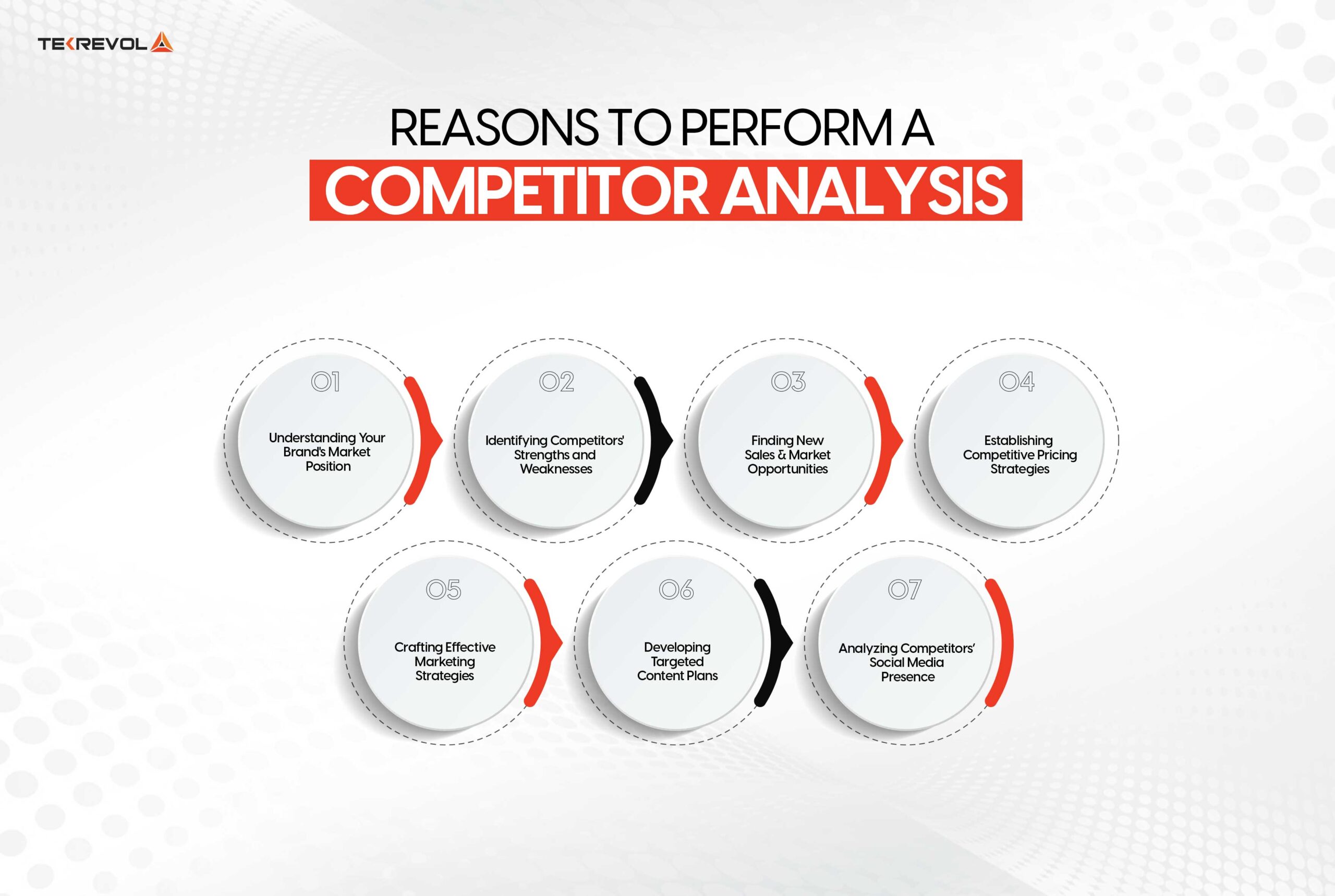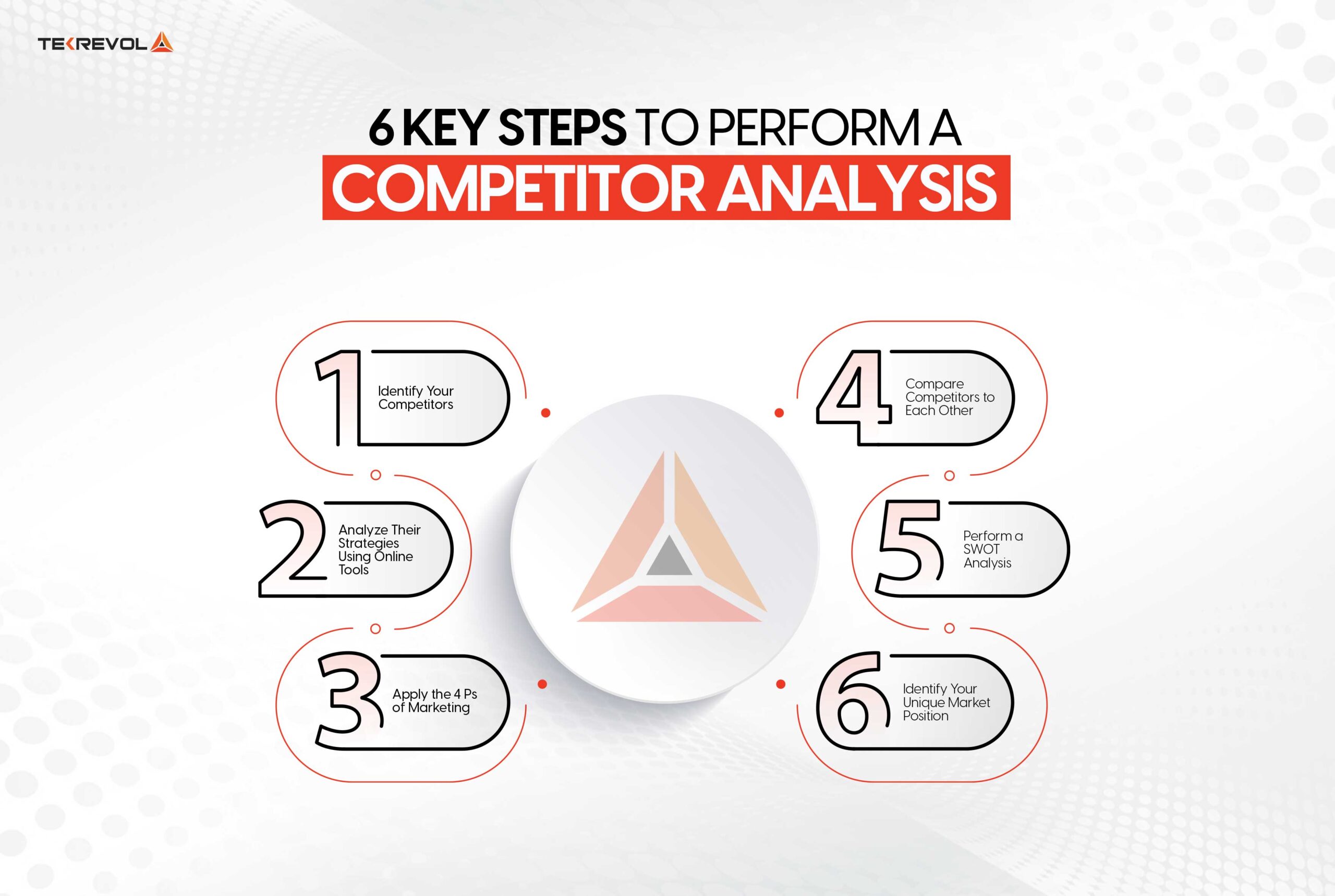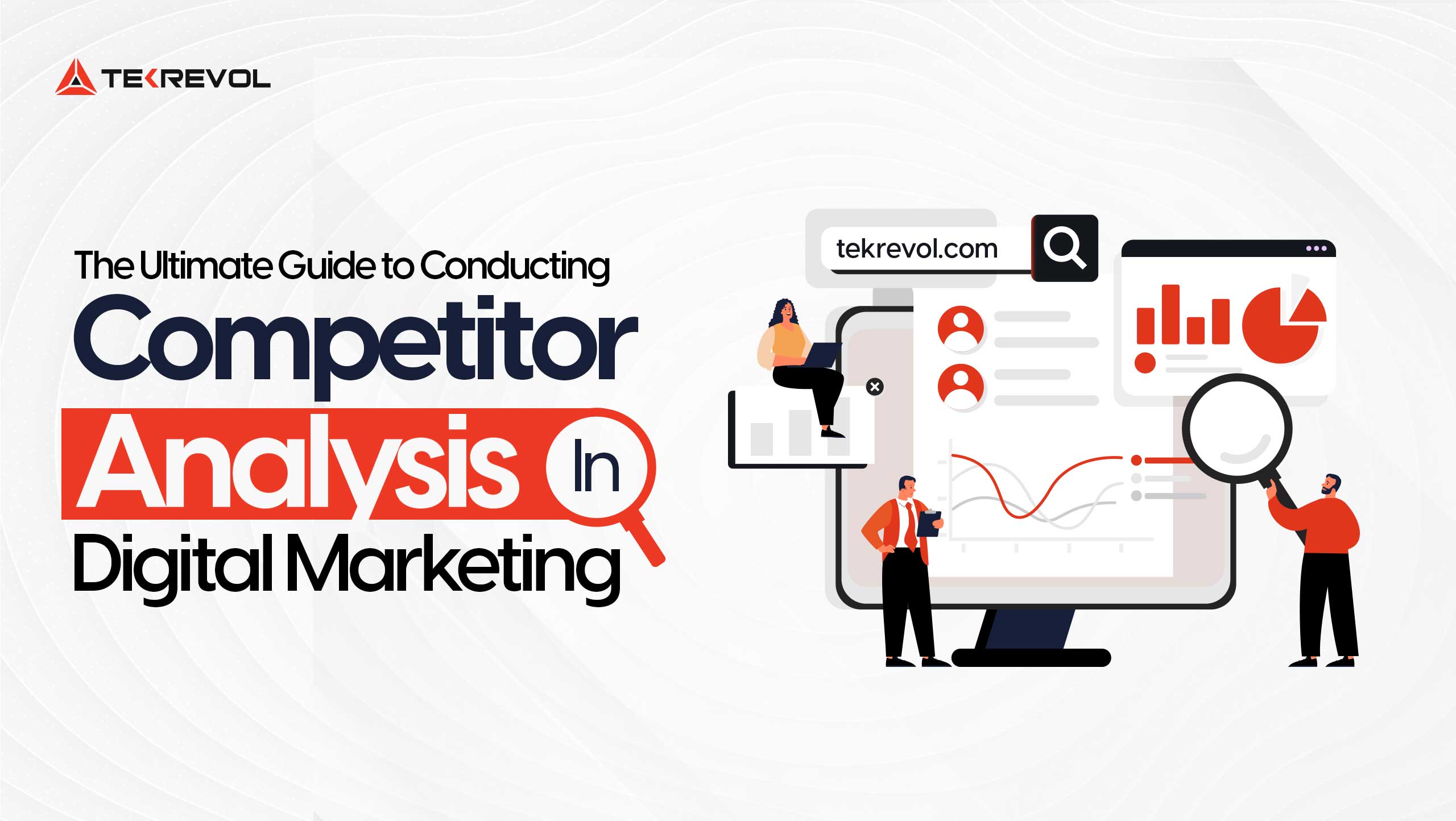Do you ever think, why do some brands seem to have a magnetic pull on customers, while others struggle to make an impact? A well-executed digital competitor analysis is the reason. By performing a competitor analysis, you can effectively assess your company’s standing against rival brands and uncover the strengths and weaknesses of other market players.
Therefore, to remain competitive and innovative, companies must analyze their competitors’ capabilities. Analyzing what competitors are up to helps organizations make smarter plans to engage customers and refine their approaches.
Whether managing a growing business or starting fresh, a digital marketing agency can help you leverage competitive analysis to enhance your strategies and stand out. In this blog post, we’ll let you know how to do a digital marketing competitive analysis and pinpoint strategies to outpace the top brands in the marketplace.
- Are you ready to elevate your marketing strategy?
- We help you plan a marketing strategy for your business that aligns with your goals & maximizes your ROI!
What Is Digital Marketing Competitive Analysis?
Competitive analysis in digital marketing entails acquiring and analyzing data about competitors to identify exploitable loopholes. This process involves analyzing different operations activities, including marketing, pricing, product development, and distribution.
Using a robust competitor analysis framework, you can pinpoint market trends and use this insight to craft strategies that improve brand visibility and strengthen customer engagement.
These initiatives ultimately drive revenue growth, strengthen your brand’s positioning, and enable you to capitalize on previously untapped opportunities.
Different Types Of Digital Competitive Analysis

There are various types of competitive analysis, and each is intended to serve specific niches of interest based on the objectives and needs of your organization. Each methodology is designed to target particular areas that can be leveraged to improve key performance indicators (KPIs) such as leads, revenue, and brand awareness.
Below are some of the major types of digital marketing competitive analysis that focus on key digital marketing channels.
Social Media Competitor Analysis
Social media has become a powerful channel, especially driving customer engagement and lead generation, with social commerce on the rise. It is therefore vital for effective targeting to know where your audience spends most of their time online.
A digital marketing competitive analysis will tell you which sites your competitors are using, plus an assessment of demographics among their followers and an assessment of their content strategy.
Track the frequency of posts, the kind of content published (videos, links to blog articles, for example), as well as any themes or topics present in posts overall. Additionally, pay attention to the nature of comment interaction and general engagement rates to see what’s grabbing attention.
PPC Competitor Analysis
A PPC competitor analysis is a procedure for determining which keywords or phrases your competitors are bidding on. The plan is to develop PPC ads to get ahead of them.
Observe their ad format and what platforms they are targeting. Are they going after high-cost keywords or phrases that will drive conversion? Check their landing pages also to know whether they use custom ones for campaigns or just lesser core pages. This will let you in on the competitor’s goals, budget, and approach to paid advertising.
SEO Competitor Analysis
The SEO competitor analysis shows you the keywords your competitors rank for, giving you a clear picture of their priority areas so you can strategize to rank higher on crucial terms. Some techniques for this include the following:
- Web performance metrics such as page speed
- Keyword gaps
- Backlinks and source evaluation
- The content strategy of how they rank better, i.e., blogs or resource pages
- Investigating the factors that contribute to the success of high-performing pages and traffic sources
These techniques can help you create a plan that will increase the visibility of your website in search results.
Top Digital Competitor Analysis Tools To Streamline Your Research

Many competitor analysis tools can help make your data collection process streamlined and even more accurate and efficient. Some of the better tools falling into these categories are:
SEO Analysis Tools
Ahrefs: Assists in finding the most performing keywords of any website and even estimates keyword traffic.
SE Ranking: Gives an overview of your paid and organic search performance, and also keyword rankings.
PPC Analysis Tools
SEMRush: It provides a full site audit, gives an insight into competitors’ keywords, and does an analysis of the backlinks.
SpyFu: Check competitor’s top-performing PPC keywords to ensure you win more campaigns.
Google Ads Auction Insights. This shows your ad’s performance against competing advertisers that are bidding on the same keywords.
Keyword Analysis Tools
SimilarWeb: Provides insights into site and channel traffic, identifies keywords, and displays engagement data to help you fine-tune your approach.
Social Media Analysis Tools
Sprout Social: It tracks follower growth, engagement rates, hashtag trends, conversion, and paid content performance.
Facebook Ad Library: The capability of searching and viewing ads that are currently running on Facebook, Instagram, and other Meta services.
AI-Powered Competitor Research Tools
Brandwatch: This monitors the online presence of rival brands, providing useful insights into how they are perceived by audiences.
Sprout Social: An AI tool that helps analyze the social performance of competing brands.
Additional tools you may consider are Google Trends, TikTok Creative Center, and Meta Ads Library for an even bigger picture of your competitors. Of course, your AI assistant ChatGPT is always available to help synthesize and analyze the insights from these tools for deeper competitor analysis.
Reasons To Perform A Competitor Analysis

Conducting competitor analysis is essential in planning business strategies, especially when launching a product, hosting an event, or executing a marketing plan. Making informed decisions requires a well-researched understanding of the competitive landscape. Here’s why competitor market strategy analysis and comparison reports are necessary at the planning stage and beyond.
Understanding Your Brand’s Market Position
Competitor analysis gives a factual approach to understanding the position of your brand in the market. With data, it is easy to discover which businesses dominate your market, which brands are more popular than yours, and what measures you need to take to overcome them. These reports also help understand what makes your brand stand out from the others, and what benefits and special features can be used in promotional campaigns.
Identifying Competitors’ Strengths and Weaknesses
Knowing the competitor’s market strategy, strengths, and weaknesses is very fundamental especially when you are developing your product or service. As an example, if a competitor has a major weakness in a certain service area, then you can cater to that specific need better than the competition. It not only aids in strategy formulation in reaching customers but also formulates product ideas that can fill the gaps that customers may feel because of existing products by other firms.
Finding New Sales & Market Opportunities
Competitive analysis can also disclose hidden business opportunities. For example, if one company targets children and teenagers while the other targets the elderly, you may notice a lack of products that cater to the needs of young people. This means that identifying these gaps provides a window through which you can reduce competitive pressure and pursue new opportunities.
Establishing Competitive Pricing Strategies
Pricing always has a great impact on consumer purchasing decisions. Based on your competitor research, you shall set rational pricing strategies that win the market while keeping off the erosion of profit margins. You determine the appropriateness of your price point by researching competitors’ pricing before you launch products or services.
Crafting Effective Marketing Strategies
A study of your competitors can teach you a thing or two from their successes and failures. When you review what works and what does not, you will avoid mistakes they made and improve upon your strategies. For example, if a competitor’s campaign does not resonate with its target demographic, you can change your strategy to ensure that your messaging aligns more closely with customer expectations.
Moreover, competitor analysis also allows you to narrow down your marketing messages so that you can emphasize exactly what sets your product apart.
If you identify that other companies’ products have noise interference problems, you can leverage this by marketing your product with a statement like, “Enjoy crystal-clear sound with our portable speaker, designed to prevent noise interference for flawless streaming.”
Developing Targeted Content Plans
Detailed research of your competition can help you plan your content strategy. You may identify where your competitors dominate and where they do not exist, and then attract search engine traffic to your site. This will assist you in accessing tools that can extract relevant keywords and enhance your content properly.
Additionally, you can make sure that your postings are more visible and interesting to your target audience by researching the hashtags that your rivals use on social media.
Analyzing Competitors’ Social Media Presence
It is highly important to track what your competitors are doing and posting on their social media, because the audience may be interested in your brand as well. So, analyzing your competitors’ presence, engagement of what they post, and where they exist will determine the best platforms for your brand and help you create engaging content with your target audience.
- Still confused about how to personalize your digital marketing strategy?
- TekRevol is here to assist you in developing customized digital marketing solutions that make an impact.
6 Key Steps To Perform A Digital Marketing Competitive Analysis

An effective online competitor analysis requires a real approach for any organization seeking to maintain its position ahead in this competitive field. By following a systematic process, it will yield some invaluable insights that can aid in further strategic practices to attain maximum performance. Here are six crucial steps to execute a comprehensive online competitor analysis.
1. Identify Your Competitors
The process begins with identifying your key competitors. You might have already identified some direct competitors, but do not underestimate companies that do not seem to represent a potential threat right now. These businesses may become capable and start targeting your customers someday. As you discover more and more rivals, group them into the following categories:
Direct Competitors: Organizations that deal with the same goods or services and reach the same population.
Indirect Competitors: Organizations that provide comparable services yet may operate in different markets or offer various products.
Emerging Competitors: Organizations that currently target other markets but can alter their approaches and compete for your customers in the near future.
Future Competitors: Startups or businesses in adjacent industries that could develop similar offerings.
2. Analyze Their Strategies Using Online Tools
The advancement of digital tools makes competitor analysis easier and faster. Start by looking through the websites of rival companies to find out about their leadership, goods, services, and core beliefs. Social media gives one insight into their client base and audience communication strategies.
Dive deeper using tools like Ubersuggest, SEMRush, and other competitor analysis platforms that we have mentioned above. These tools have provided amazing information on keywords, what pages people perform best on, traffic, and even content strategy. Understanding this data will let you better position your business against their tactics.
3. Apply the 4 Ps of Marketing
Understanding the 4 Ps of marketing Product, Price, Promotion, and Place also adds more depth to your competitor’s strategies as follows:
Product: What products or services do they offer? Assess customer feedback to understand what aspects of their offerings resonate most. Identify any unique features that may give them an edge over your products.
Price: Analyze their pricing model. Is it a one-time payment or a subscription service? Understand what makes their pricing appealing to customers and how it compares to your pricing strategy.
Promotion: Analyze how they promote their brand and products. What digital channels are most important? What marketing tactics are they using to reach their audience? This might include social media, email marketing campaigns, or influencer partnerships.
Place: Where do they sell? Online, or do they have actual stores? Knowing their delivery channels can help identify potential holes in your strategy.
One could get helpful insights from this investigation that would direct their marketing approach.
4. Compare Competitors to Each Other
A comparative analysis must not only take place between your business and its competitors but also among the different types of competitors. Each of them has different strengths, weaknesses, and strategic approaches.
The creation of comprehensive profiles and the comparison of their products, services, markets targeted, geographically, and demographics allow for a clearer understanding of how each entity operates.
It will also point out how your business is positioned in comparison to its competitors, and what they are doing that is ‘better.’ Now, apply all this to fine-tuning strategies for the next steps in the process.
5. Perform a SWOT Analysis
A SWOT analysis, which encompasses Strengths, Weaknesses, Opportunities, and Threats, constitutes an essential component of competitor research. This evaluative process enables one to perceive the business from the perspective of its customers and to comprehend its position relative to competitors.
Strengths: What does your business do best that others cannot?
Weaknesses: Where do your competitors outperform you?
Opportunities: Are there industry trends or changes in competitors that you can exploit?
Potential Risks: What threats or competitive moves could harm your organization?
By comprehending these facets, one will reveal potential areas for enhancement and novel opportunities that can be utilized in marketing and operational strategies.
6. Identify Your Unique Market Position
Finally, to correctly determine distinctive market positioning, you must apply the knowledge you have obtained from both the competitor and SWOT analysis.
Your organization, like the others, should have distinguishing features. Such distinctiveness could be a specific product or service, a lower price, or a better fit with the clientele’s values.
Understanding and capitalizing on your company’s distinct advantages will help set it apart from rivals and strengthen your brand’s position in the industry.
- Want to Develop a New Marketing Plan For Your Business?
- Our team will help you uncover insights and strategies customized to your business needs.
Wrapping Up
Developing a strong marketing plan takes more than just internal insights, you need to understand your competitors thoroughly. While the internet makes it easier to obtain this information, navigating the competitive analysis landscape may still be difficult, particularly for individuals who are new to the practice.
If you’re ready to explore your industry and capitalize on competitive insights to improve your marketing efforts, partner with TekRevol. As a renowned digital marketing agency, we are here to help you uncover important data and trends that inform your strategic decisions. Our professional team collaborates with you to analyze competitors, identify opportunities, and craft tailored solutions that drive impactful results.
- Are you ready to take the first step toward achieving your goals?
- Kickstart your marketing Plan with TekRevol!

 1993 Views
1993 Views November 12, 2024
November 12, 2024









